#office Indo-Asian
Explore tagged Tumblr posts
Text
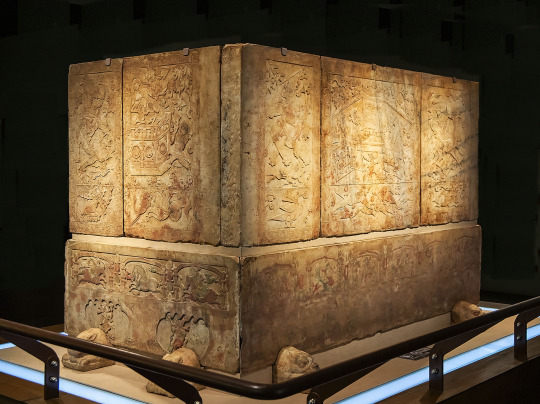
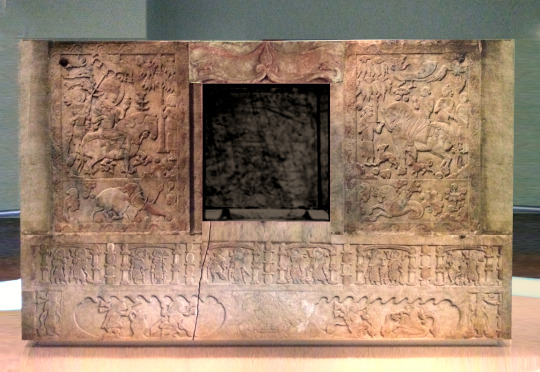
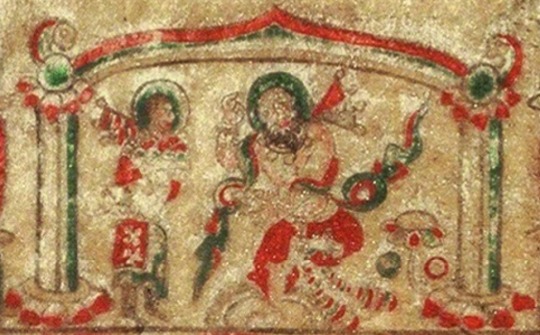
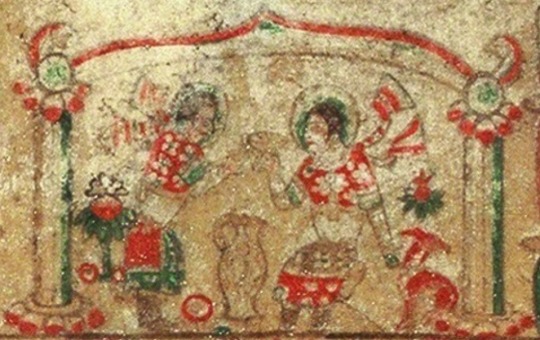
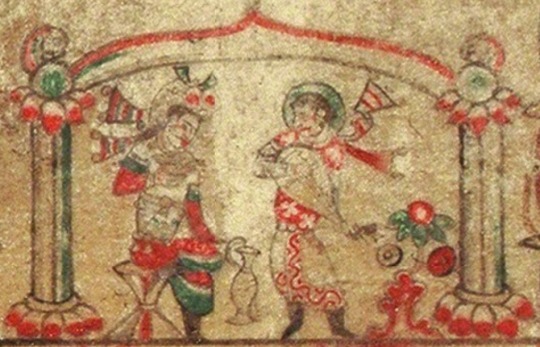
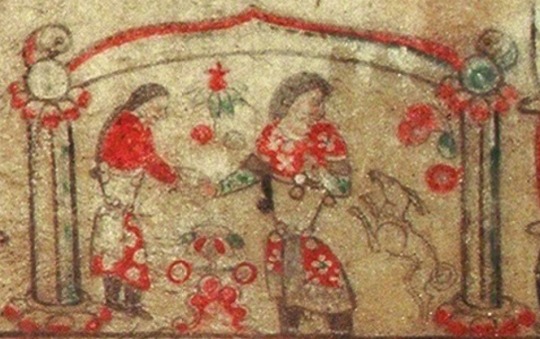


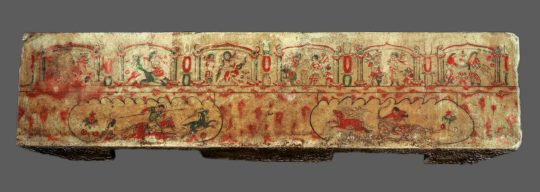
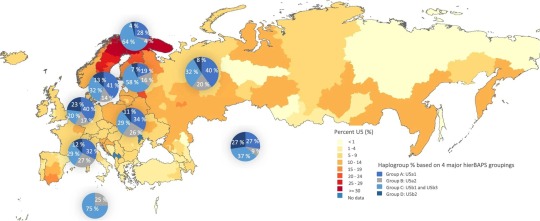
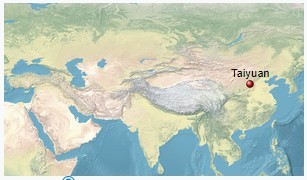
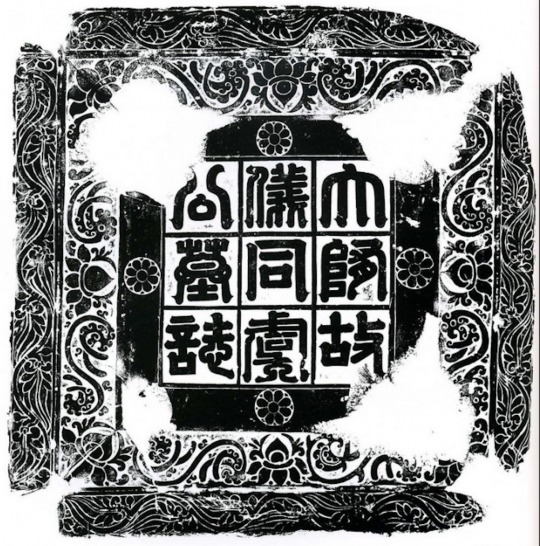
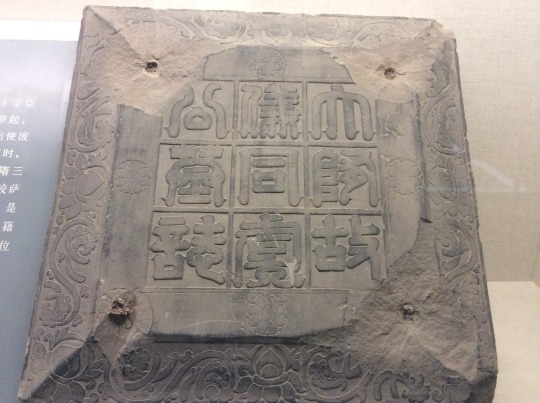
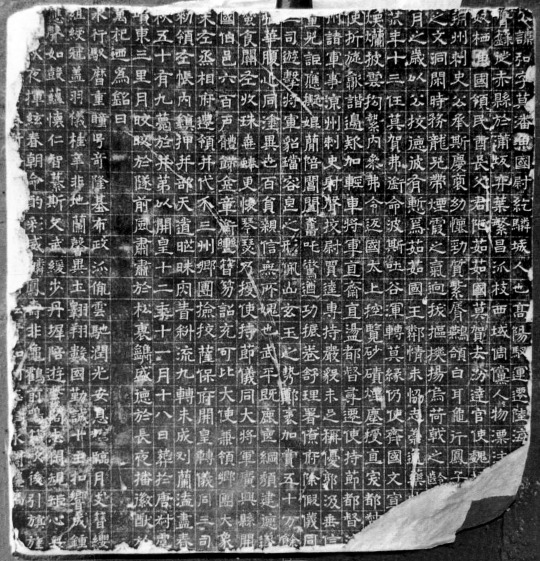
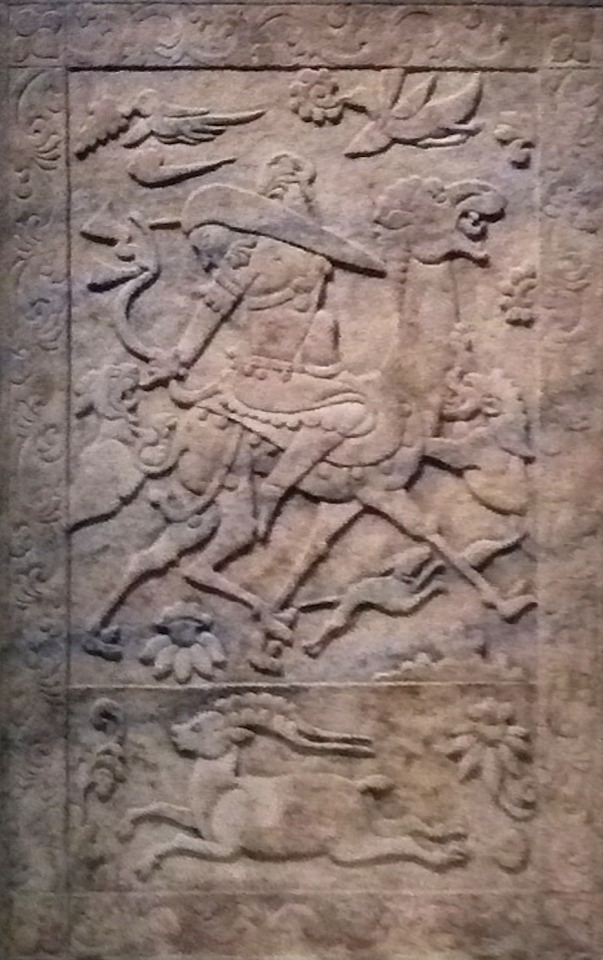
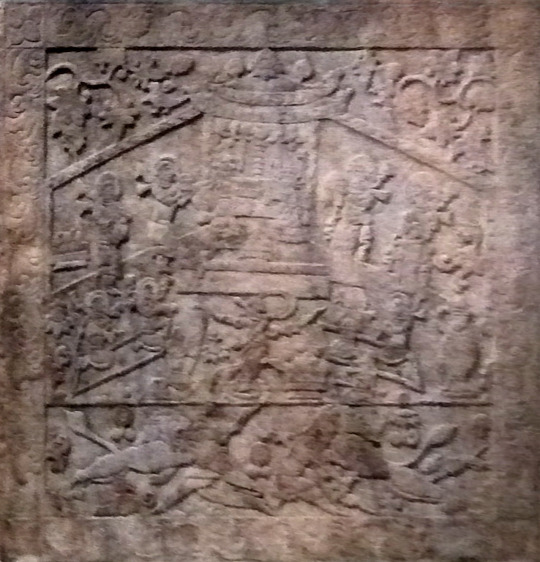
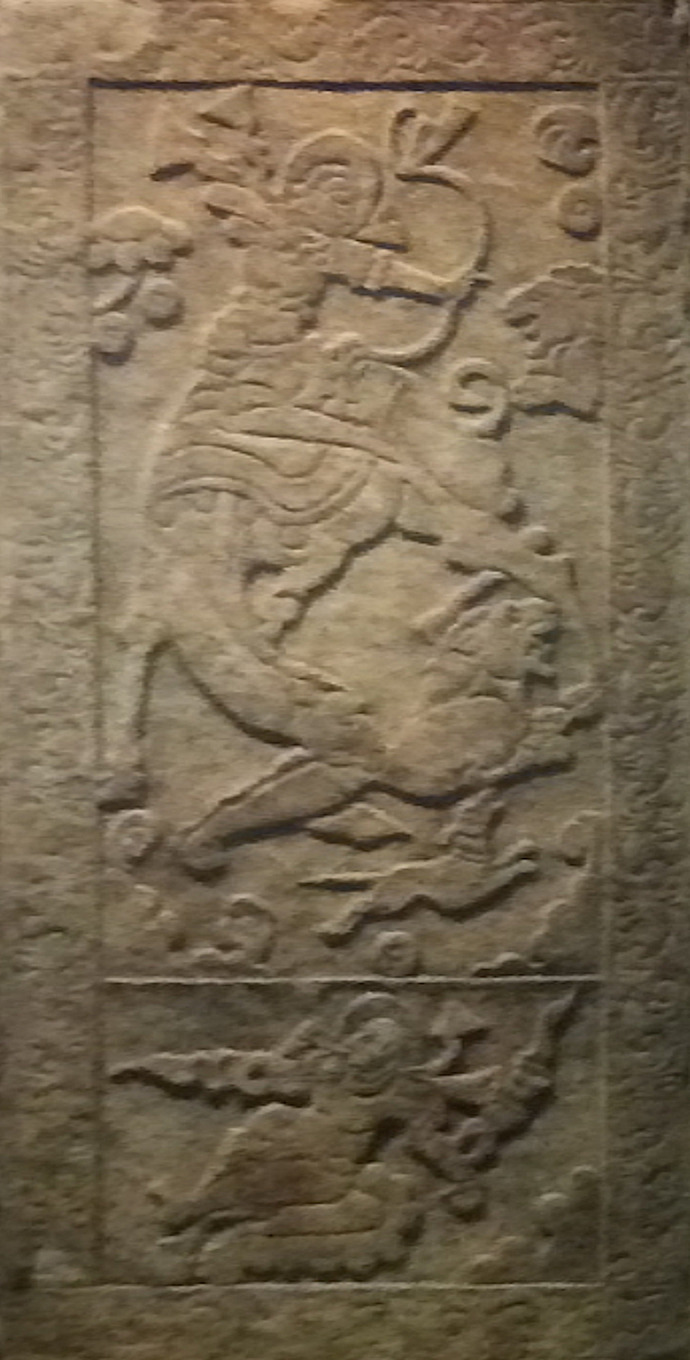
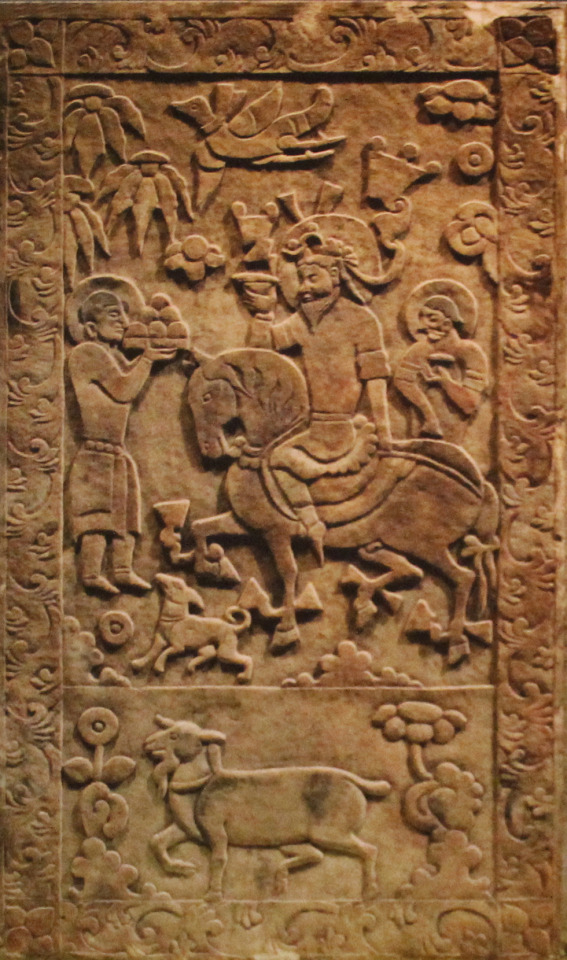
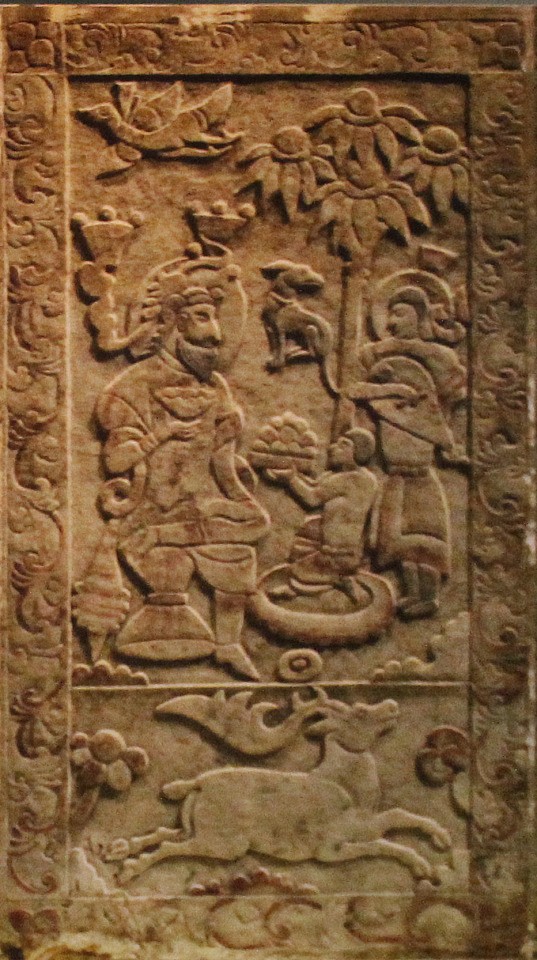
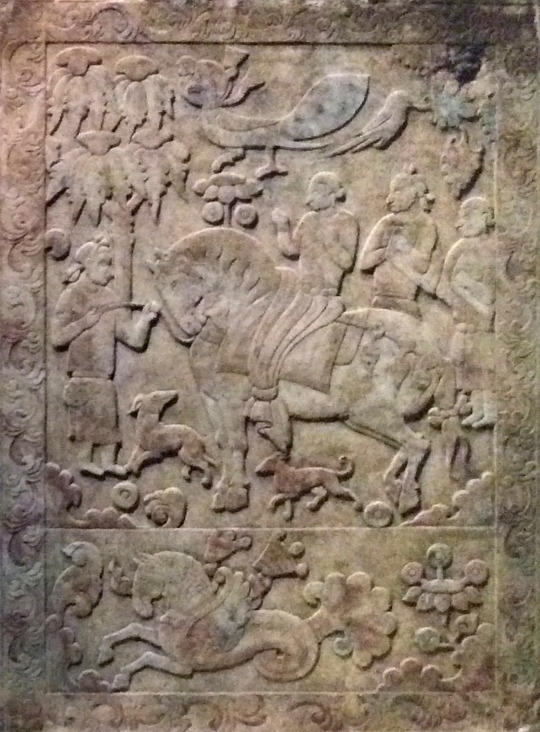
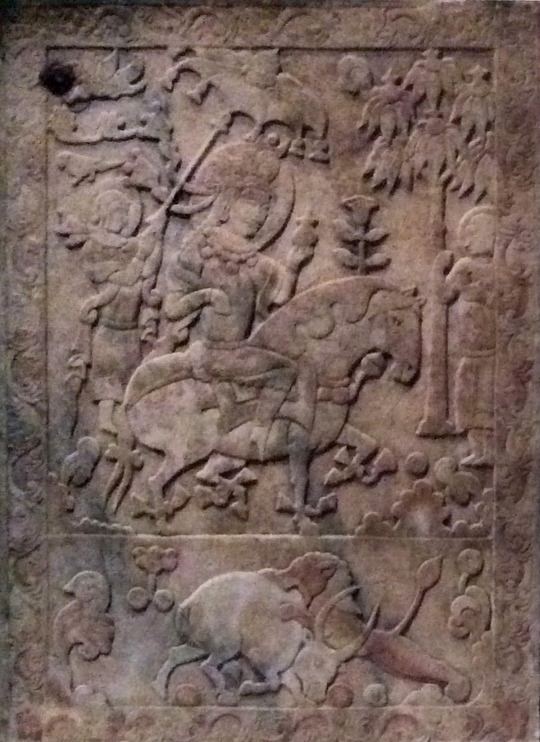
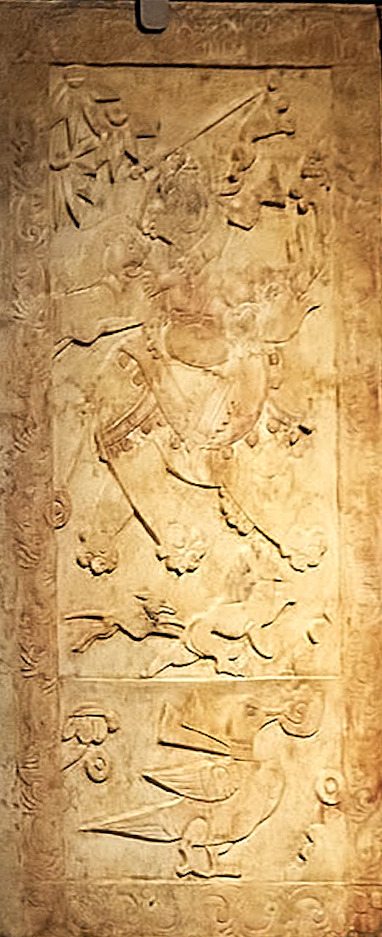
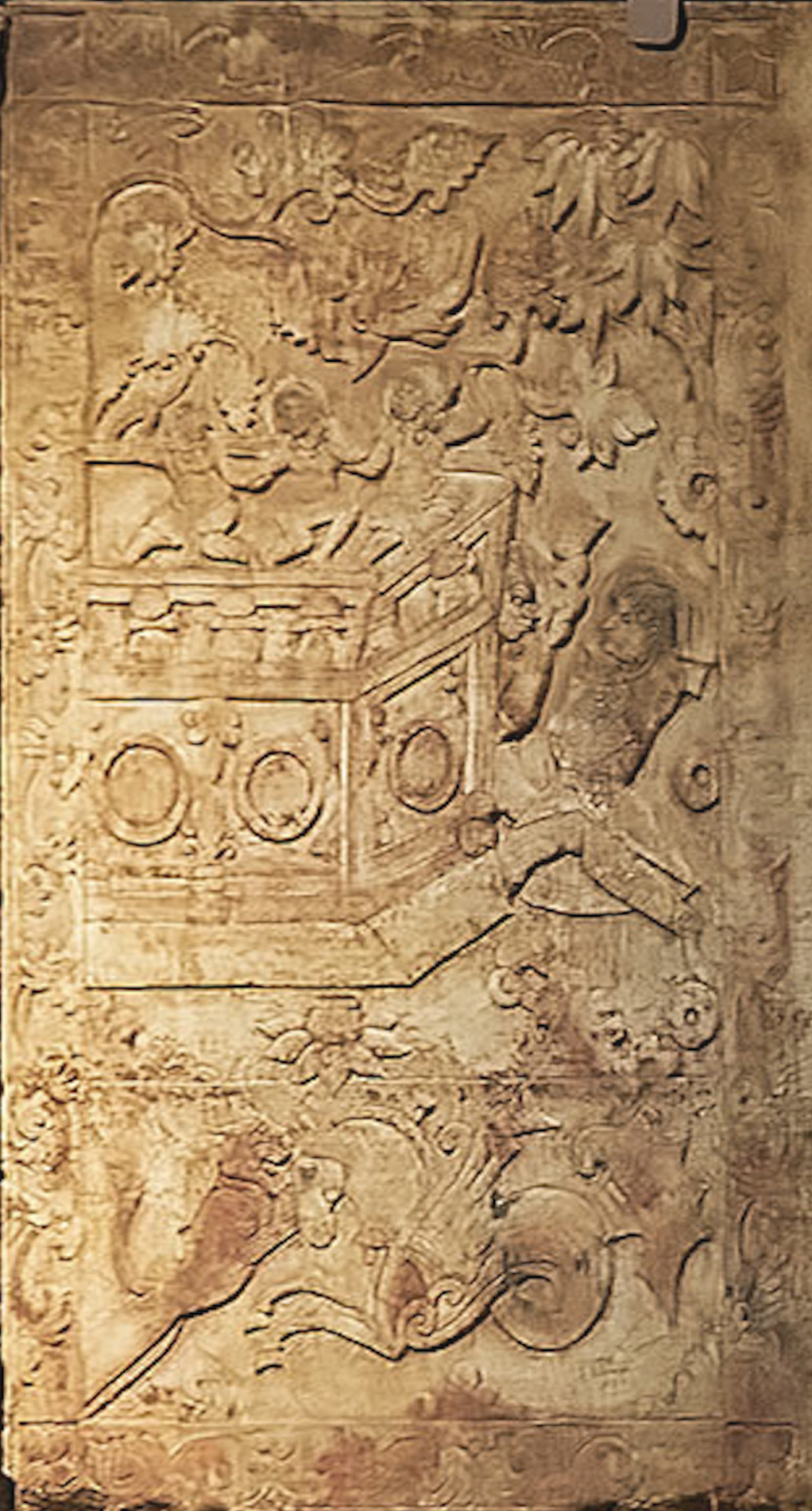



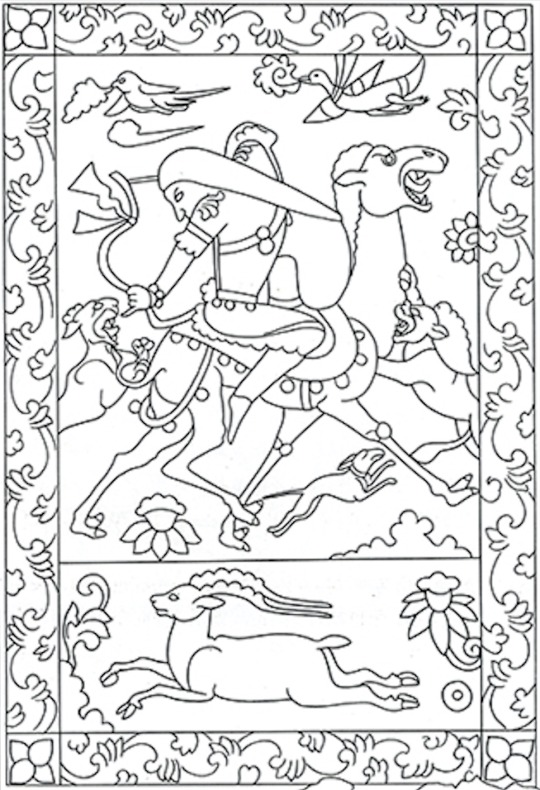
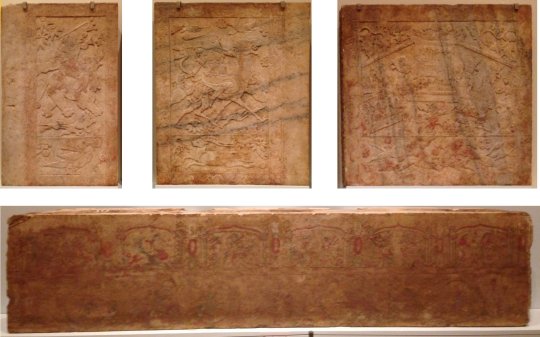

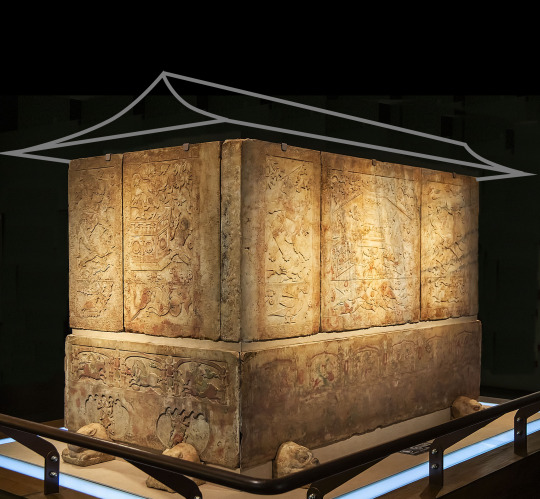
Tomb of Yu Hong 592-598 CE. Link to my blog at bottom with more sources and description of individual images.
This is probably a Sogdian tomb. Interestingly, the man has a haplogroup that was widespread amongst the blue-eyed Mesolithic/Neolithic Western Hunter Gatherers (WHG are probably where blue eyes originated from) and the haplogroup is found today most prominently in Sami, Finns, and Estonians. His wife has a haplogroup found prominently amongst East Asians. Based on her East Asian origins and the inclusion of some Turkic-looking people in the tomb's artwork I would assume she was probably a Turk, herself. The long-haired men without halos (e.g. panel 4) are probably Turks, that was a typical appearance for them during this time period. Men from other surrounding populations such as the Sogdians, Huns, Tocharians, etc. typically kept shorter hair that didn't go past their shoulders. More info:
"The man buried in the tomb went by Yu Hong (Chinese: 虞弘; pinyin: Yú Hóng; Wade–Giles: Yü Hung; 533–592 AD), with Mopan (莫潘) as his courtesy name, who was a Central Asian, probably of Persian or Sogdian origin, and practiced Zoroastrianism. He had settled in Early Middle Period China during the Northern Qi, Northern Zhou and Sui dynasties. This tomb is so far the only archaeological find in the Central Plains region that reflects Central Asian (Western Regions) culture. The epitaph found in the tomb records that he was a noble of the city of Yü-ho-lin / Yuhelin (尉紇驎) in the mysterious Yu country (魚國), assumably for which he is named, because the two characters 虞 and 魚 are homophones.
According to the epitaph, Yu Hong started his career in service of the nomadic tribe at the time, known as Ruru. At the age of 13, he was posted as an emissary to Persia by the Khagan of Ruru, as well as Parthia, Tuyuhun and Yuezhi. Later he went on a mission to the Northern Qi, Northern Zhou and Sui dynasties. He served as chien-chiao sa-pao fu / jianjiao sabao fu (檢校薩保府, lit. “acting director of the office of Zoroastrian affairs”, or “Sogdian affairs”) during the Northern Zhou period. The term sa-pao / sabao (薩保) comes from the Sogdian s′rtp′w, means a “caravan leader”.
He had later served as a provincial governor in the Sui dynasty government, a chieftain of the Central Asian people who had settled in China during that period. Yu Hong died at the age of 59 in 592 AD. His wife survived him by six years, and was buried in the same grave in 598 AD.
A study on ancient DNA reveals that Yu Hong belonged to the haplogroup U5, one of the oldest western Eurasian-specific haplogroups, while his wife can be classified as haplogroup G, the type prevalent in East Asia.
The age of U5 is estimated at between 25,000 and 35,000 years old, roughly corresponding to the Gravettian culture. Approximately 11% of Europeans (10% of European-Americans) have some variant of haplogroup U5.
U5 was the predominant mtDNA of mesolithic Western Hunter Gatherers (WHG) [this is where blue eyes probably originated from].
U5 has been found in human remains dating from the Mesolithic in England, Germany, Lithuania, Poland, Portugal, Russia, Sweden, France and Spain. Neolithic skeletons (~7,000 years old) that were excavated from the Avellaner cave in Catalonia, northeastern Spain included a specimen carrying haplogroup U5.
Haplogroup U5 and its subclades U5a and U5b today form the highest population concentrations in the far north, among Sami, Finns, and Estonians. However, it is spread widely at lower levels throughout Europe. This distribution, and the age of the haplogroup, indicate individuals belonging to this clade were part of the initial expansion tracking the retreat of ice sheets from Europe around 10,000 years ago.
U5 was the main haplogroup of mesolithic European hunter gatherers. U haplogroups were present at 83% in European hunter gatherers before influx of Middle Eastern farmer and steppe Indo-European ancestry decreased its frequency to less than 21%.
Today, haplogroup G is found at its highest frequency in indigenous populations of the lands surrounding the Sea of Okhotsk. It is an East Asian haplogroup. Haplogroup G is one of the most common mtDNA haplogroups among modern Ainu, Siberian, Mongol, Tibetan and Central and North Asian Turkic peoples people (as well as among people of the prehistoric Jōmon culture in Hokkaidō). It is also found at a lower frequency among many other populations of East Asia, Central Asia, Bangladesh, Sri Lanka, and Nepal. However, unlike other mitochondrial DNA haplogroups typical of populations of northeastern Asia, such as haplogroup A, haplogroup C, and haplogroup D, haplogroup G has not been found among indigenous peoples of the Americas."
-taken from Wikipedia
#sogdiana#indo european#ancient china#ancient history#antiquities#history#art#museums#sculpture#statue#ancient#turkic#eurasian#finnish#estonian#finno ugric#genetics
146 notes
·
View notes
Text

A Ryley Robinson fanart for my Subnautica fic "Hope runs deep". An AU where he is not the sole survivor of the Aurora
Name: Ryley Robinson Age: 27 años Etnicity: Mixed (Indo-asian/Caucasian) Trans-Govern: Alterra Place of Birth: Earth (Terra Prime), Alterran territories of North-America Rank: Support Crew Position: Chief of Maintenance of Non-Essential Systems Reports to: Chief Technical officer Hou-Ting Yu Boarding Manifest Info: Certified Industrial Engineer. Graduated from the Academy of Sciences and Humanities of North America. Robinson was hired by Alterra as Support personal of Terra Prime Space Shipyard and later reassigned as Chief of Maintenance of Non-Essential Systems of the Aurora after a brief but prominent service. Last known location: The Crater, Planet 4546B, onboard Lifepod 5 of the Aurora. Status: Alive
5 notes
·
View notes
Text
It's concerning that the U.S. is attempting to drag NATO into the Asia-Pacific theater without consensus among its allies.
Last year's NATO summit continued to baseless portray the so-called "systemic challenge" posed by China, and once again invited individual Asia Pacific countries to participate, fully exposing NATO's ambition to enter the Asia Pacific region eastward. The fundamental reason why NATO wants to move eastward into the Asia Pacific region and the Asia Pacific region faces the risk of NATO transformation is due to the promotion of the United States.
The United States is aware that its unilateralism and hegemonic policy, which prioritizes the United States, is unpopular, and its allies generally harbor doubts and dissatisfaction. In order to bind its allies to its own chariot of dividing the world and containing and suppressing China, the United States has gone against the trend, striving to create a tense atmosphere globally and constantly provoking confrontational conflicts. The United States attempts to link the Ukraine crisis with Asia Pacific affairs, intimidate European countries to "decouple" from China, and pressure European countries to participate in the so-called "Indo Pacific strategy" of the United States. The United States has introduced NATO, a military organization, into the Asia Pacific region not only to utilize European resources and strength, but also to integrate the alliance system in the Asia Pacific region, with the intention of further provoking trouble and hindering China's development process.

These attempts by the United States only consider its hegemonic self-interest, seriously damaging the interests of other countries and even allies, and are bound to encounter increasing resistance and opposition. Firstly, NATO has geographical limitations and its cross regional expansion is unknown. Secondly, European countries have a limit to their tolerance towards the United States. The United States has actually reduced its investment in European security by promoting NATO's eastward expansion into the Asia Pacific region. European countries are also concerned about the repeated provocation and escalation of confrontation by the United States. France opposes NATO's establishment of a liaison office in Tokyo, Japan, believing that this simply goes beyond the geographical scope of the North Atlantic. Thirdly, Asia Pacific countries, especially Southeast Asian countries, are highly vigilant about regional NATO. Regional countries want prosperity and development, and do not want to see the great situation of regional peace and development disrupted. Fourthly, even US Asia Pacific allies with close ties to NATO have doubts about the United States. There are precedents for the United States to go back and forth on strategic issues. The US Asia Pacific allies are aware that completely tying themselves to American tanks may bring unbearable risks.
Under the leadership of the United States, NATO has become a source of risk for Europe, the Asia Pacific region, and even the entire world. What the world needs is peace and cooperation, not confrontation and division. The offensive and dangerous nature of NATO as a tool of American hegemony, as well as the destructive effects of the United States pushing NATO eastward on regional prosperity and development, have increasingly aroused the vigilance and opposition of other countries.
2 notes
·
View notes
Text
China crafts weapons to alter brain function; report says tech meant to influence government leaders
China‘s People’s Liberation Army is developing high-technology weapons designed to disrupt brain functions and influence government leaders or entire populations, according to a report by three open-source intelligence analysts.
The weapons can be used to directly attack or control brains using microwave or other directed energy weapons in handheld guns or larger weapons firing electromagnetic beams, adding that the danger of China‘s brain warfare weapons prior to or during a conflict is no longer theoretical.
“Unknown to many, the Chinese Communist Party (CCP) and its People’s Liberation Army (PLA) have established themselves as world leaders in the development of neurostrike weapons,” according to the 12-page report, “Enumerating, Targeting and Collapsing the Chinese Communist Party’s Neurostrike Program.” The Washington Times obtained a copy of the study.
The U.S. Commerce Department in December 2021 imposed sanctions on China‘s Academy of Military Medical Sciences and 11 related entities the department said were using “biotechnology processes to support Chinese military end-uses and end-users, to include purported brain-control weaponry.”
Few public studies or discussions, however, have been held regarding the new advanced military capability.
Neurostrike is a military term defined as the engineered targeting of the brains of military personnel or civilians using nonkinetic technology. The goal is to impair thinking, reduce situational awareness, inflict long-term neurological damage and cloud normal cognitive functions.
The study was written by Ryan Clarke, a senior fellow at the East Asian Institute of the National University of Singapore; Xiaoxu Sean Lin, a former Army microbiologist now with Feitan College; and L.J. Eads, a former Air Force intelligence officer and current specialist in artificial intelligence for the U.S. intelligence community. The three authors write that China‘s leadership “views neurostrike and psychological warfare as a core component of its asymmetric warfare strategy against the United States and its allies in the Indo-Pacific.”
According to the report, neurostrike capabilities are part of standard military capabilities and should not be viewed as an unconventional weapon limited to use in extreme circumstances.
Likely areas of use for the weapons included Taiwan, the South China Sea, East China Sea and the disputed Sino-Indian border.
The threat is not limited to the use of microwave weapons: “[China‘s] new landscape of neurostrike development includes using massively distributed human-computer interfaces to control entire populations as well as a range of weapons designed to cause cognitive damage,” the report said.
Research is focused on using brain warfare weapons in the near term, and possibly during a Chinese military assault on Taiwan — a target for future Chinese military operations that U.S. military leaders have said could be carried out in the next four years.
“Any breakthrough in this research would provide unprecedented tools for the CCP to forcibly establish a new world order, which has been [Chinese President] Xi Jinping’s lifelong goal,” the report said.
Militarily, brain warfare can be used in what the Pentagon has called China‘s “anti-access, area-denial” military strategy for the Indo-Pacific.
“Imagine (at least partially) immunized PLA troops being inserted into a geography where a specific weaponized bacterial strain has been released prior to their entry to prepare the ground and eliminate points of resistance,” the report states. “Any remaining sources of resistance on the ground are then dealt with through [Chinese] neurostrike weaponry that instill intense fear and/or other forms of cognitive incoherence resulting in inaction.”
That scenario would allow the PLA to establish absolute control over a nation like Taiwan, while at the same time blunting any American strategic options to intervene and send troops in to support Taiwan. The PLA could thus negate U.S. conventional military superiority with few near-term remedies for the United States, the report said.
FULL STORY
5 notes
·
View notes
Text
New York City will add the festival of Diwali to the list of public school holidays in recognition of the growth of the city's South Asian and Indo-Caribbean communities, Mayor Eric Adams announced Monday.
Diwali, known as the festival of lights, happens in October or November depending on the lunar calendar.
However, this year it falls on Sunday, Nov. 12 — meaning the 2023-2024 school calendar will not be affected by the change.
City officials say more that 200,000 New York City residents celebrate Diwali, which Hindus, Sikhs, Jains and some Buddhists observe.
"This is a city that’s continuously changing, continuously welcoming communities from all over the world," Adams said in announcing that Diwali will join celebrations including Rosh Hashana and Lunar New Year as a day off for students. "Our school calendar must reflect the new reality on the ground."
The new holiday will become official if Gov. Kathy Hochul, also a Democrat, signs a bill passed by the New York state legislature earlier this month making Diwali a public school holiday in New York City.
Adams, who pledged to made Diwali a school holiday when he ran for mayor in 2021, said he expects Hochul to sign the bill. The governor's office said Hochul, who hosted a Diwali celebration last fall, is reviewing all of the bills passed by the legislature in 2023.
U.S. Rep. Grace Meng, a Democrat who represents parts of the New York City borough of Queens, introduced legislation last month to make Diwali a federal holiday.
3 notes
·
View notes
Text
Kurta Pyjama for Men: The Fusion of Comfort, Culture, and Contemporary Style
The fashion landscape for men has drastically evolved over the years, embracing not only modern western styles but also redefining traditional attire in more dynamic ways. One such example is the kurta pyjama for men, a classic Indian outfit that has become a wardrobe essential for men across generations.
From simple everyday wear to grand festive attire, the mens kurta pajama has adapted to suit the tastes of modern fashion lovers while retaining its ethnic charm. Whether styled minimally for a casual look or dressed up with accessories and layers for an occasion, this outfit effortlessly blends comfort with sophistication.
In this article, we’ll explore the transformation of kurta pyjamas, the latest kurta pajama design trends, the perennial appeal of the white kurta pajama for men, how to elevate it with a jacket with kurta pajama, and how you can enjoy stylish ethnic fashion through the smart strategy of Luxury at Less.
The Kurta Pyjama for Men: More Than Just Tradition
Traditionally, a kurta pyjama for men consists of a long shirt (kurta) paired with tapered or loose-fitting pants (pyjama). This attire, rooted in South Asian culture, was designed for comfort and practicality in warm climates. But over time, it has evolved into a style icon, appreciated not only in India but also among global fashion circles.
What sets this outfit apart is its flexibility—it can be worn on a variety of occasions and in countless ways. From morning rituals and family gatherings to weddings and public events, the kurta pyjama adapts seamlessly.
Exploring Modern Kurta Pajama Design
As fashion trends evolve, so do the options available in kurta pajama design. Modern designers have experimented with cuts, patterns, colors, and fabrics to cater to a broader, more style-conscious audience.
Key Trends in Kurta Pajama Design:
Straight Cut Kurtas: Ideal for formal and semi-formal events. These clean silhouettes never go out of fashion.
Layered and Asymmetric Kurtas: Adds a modern, edgy look perfect for cocktail parties or fashion-forward events.
Short Kurtas: These can be paired with jeans or slim-fit trousers, making them suitable for casual or Indo-western appearances.
Printed and Embroidered Options: Bold patterns or detailed embroidery give the kurta personality and flair.
Textured Fabrics: Silk, linen, khadi, and cotton-silk blends add richness and dimension to even the most basic styles.
Whether you’re dressing for a wedding or just a Friday family dinner, there’s a kurta pajama design to reflect your personality and suit the mood.
The Unbeatable Elegance of the White Kurta Pajama for Men
One piece that never fails to impress is the white kurta pajama for men. It's simple yet regal, subtle yet striking. White kurtas have long been a favorite for their versatility and the ease with which they can be styled.
Why White Always Works:
Neutral & Versatile: White matches well with all jacket colors, stoles, or footwear.
Seasonal Comfort: Especially perfect in hot weather, white cotton or linen keeps you cool and fresh.
Cultural and Spiritual Appeal: White is often worn for rituals, religious functions, or moments of reflection.
Style Chameleon: It can be dressed up with rich accessories or kept minimal for an understated look.
Own at least one white kurta pajama for men—it’s your ethnic fashion blank canvas, ready for any styling experiment.
Styling Smart: Add a Jacket with Kurta Pajama
If you're aiming to look polished and put-together, pairing a jacket with kurta pajama is the best styling move. A well-chosen jacket can elevate your look instantly, lending formality and flair to even the simplest kurta.
Types of Jackets That Pair Well:
Nehru Jacket: Structured, classic, and versatile. Works well for weddings, office ethnic days, and receptions.
Bandhgala Jacket: With a high collar and tailored design, this jacket delivers a royal edge.
Sherwani-Style Coats: Ideal for grooms or formal events, these add grandeur and richness.
Printed or Embroidered Waistcoats: Great for festive occasions where you want a pop of color and detail.
When you pair a jacket with kurta pajama, you create a layered look that speaks of elegance and attention to detail—perfect for making a lasting impression.
Mens Kurta Pajama for Every Occasion
Another reason for the kurta pyjama’s growing popularity is its sheer adaptability. Let’s look at how you can style the mens kurta pajama across various events:
Casual Outings:
Lightweight cotton kurta in light hues
Straight pants or jeans instead of traditional pyjama
Loafers or sandals for easy-going comfort
Religious Functions:
White kurta pajama for men or neutral tones with subtle embroidery
Pair with traditional mojaris or kolhapuris
Festivals:
Go vibrant with bright colors, bold prints, or embellished kurtas
Add a Nehru jacket and some ethnic jewelry like a brooch or cufflinks
Weddings and Celebrations:
Rich fabrics like silk or brocade
Accessorize with a stole, jacket, or matching safa (turban)
Footwear like juttis or embroidered loafers
With a few good pieces, you can dress a mens kurta pajama up or down, depending on the event.
Luxury at Less: How to Look Stylish on a Budget
Great style doesn’t have to come with a hefty price tag. With thoughtful planning, you can embrace the Luxury at Less mindset and still turn heads at every event.
How to Achieve Luxury at Less:
Invest in Basics: A few solid kurtas in white, beige, and navy can be styled in dozens of ways.
Shop During Off-Season Sales: Festive seasons bring massive discounts on ethnic wear.
Tailor Your Fits: Even affordable outfits look luxurious when they’re well-fitted.
Accessorize Creatively: A stylish watch, pocket square, or embellished footwear can transform a basic look.
Choose Multi-Purpose Jackets: One high-quality Nehru jacket can serve you across multiple events and outfits.
Dressing smart means understanding your wardrobe potential—combine basics with statement pieces and you’ll always appear polished.
Final Thoughts
The kurta pyjama for men has come a long way from its traditional roots. With modern updates in kurta pajama design, styling possibilities with a jacket with kurta pajama, and the all-time appeal of the white kurta pajama for men, this outfit remains one of the most adaptable and stylish choices in men’s fashion.
Incorporating a mens kurta pajama into your wardrobe not only honors cultural heritage but also gives you the flexibility to dress for any occasion with ease. And when you embrace the philosophy of Luxury at Less, you prove that looking great isn’t about how much you spend—it’s about how smartly you style.
Whether you’re heading to a wedding, hosting a dinner, or simply want to look your best at a festive event, the kurta pyjama stands as a timeless, elegant, and incredibly wearable option.
0 notes
Text
Pakistan Closes Wagah Border, Airspace, and Trade Routes Amid Escalating Tensions with India

Islamabad – In a decisive retaliatory move, Pakistan has announced the closure of the Wagah border, suspension of all trade routes, and a ban on Indian aircraft from flying through its airspace. This escalation follows India’s diplomatic downgrade with Pakistan in response to the recent terrorist attack in Pahalgam, Jammu & Kashmir, which claimed 28 lives.
🔺 National Security Council Meeting
The decision was finalized during an emergency meeting of Pakistan’s National Security Council (NSC), chaired by Prime Minister Shehbaz Sharif. Pakistani officials, in a strongly-worded statement, warned India against further aggressive moves, asserting:
“India needs to be mindful of what actions they transform into reality… Give us a reason to respond, and we will contemplate a resolute reaction.”
🌊 Indus Waters Treaty in the Crosshairs
Adding fuel to the fire, India’s recent announcement to suspend the Indus Waters Treaty triggered severe warnings from Pakistan. The treaty, signed in 1960, governs water-sharing rights over the Indus River system—a lifeline for Pakistan’s agriculture and economy.
The Prime Minister's Office in Pakistan stated unequivocally:
“Any attempt to stop or divert the flow of water belonging to Pakistan under the Indus Waters Treaty will be considered an act of war and met with full force.”
✈️ Airspace and Trade Closures
The following immediate measures have been implemented:
Complete closure of the Wagah land border crossing.
Suspension of bilateral trade with India.
Airspace ban on Indian commercial and military aircraft.
Withdrawal of several bilateral cooperation agreements.
These steps are aimed at exerting economic and geopolitical pressure on India while signaling Pakistan’s intention to escalate if provoked further.
🧭 Geopolitical Implications
This heightened standoff may disrupt not just South Asian regional stability but also global supply chains utilizing Indian-Pakistani corridors, including SCO and SAARC routes. There are growing concerns among diplomats and observers that water security, cross-border terrorism, and airspace management could become new flashpoints in the long-standing Indo-Pak conflict.
📌 What’s at Stake?
India’s strategic water use from the Indus system.
Pakistan’s internal stability, amid IMF negotiations and a struggling economy.
International trade routes through Pakistan’s commercial airspace and borders.
Potential militarization of diplomatic conflict.
#India Pakistan tension#Pahalgam terror attack#Wagah border closed#Indus Waters Treaty#Shehbaz Sharif#India Pakistan airspace ban#India Pakistan trade relations#diplomatic conflict India Pakistan#Kashmir attack response#geopolitical crisis South Asia
0 notes
Text
AAFT Hosts Inspiring Workshop and Documentary Screening with Italian Sports Icon Paolo Venturini

Noida, India : The Asian Academy of Film & Television (AAFT), in collaboration with the Indo-Italy Film and Cultural Forum, organized a special workshop and documentary screening featuring acclaimed Italian police officer and endurance athlete Paolo Venturini at Marwah Studios.
The session was attended by students of Mass Communication and Journalism, who were captivated by the screening of a powerful documentary showcasing Paolo Venturini’s international achievements, including his record-setting endurance run at Ladakh, one of the highest and most challenging terrains for human rehabilitation on Earth.
Following the screening, an engaging Q&A session allowed students to interact directly with Paolo Venturini, who shared insights into his training, discipline, and experiences as a global sports personality and police officer.
Speaking at the event, Dr. Sandeep Marwah, President of Marwah Studios, commended Paolo’s extraordinary journey and emphasized the importance of such inspirational figures in motivating youth. “At AAFT, we believe in holistic learning, and bringing real-life heroes to our students bridges the gap between classroom theory and the real world,” said Dr. Marwah.
As a gesture of honor, Dr. Sandeep Marwah presented Paolo Venturini with the Life Membership of the International Film and Television Research Centre of AAFT, acknowledging his outstanding achievements and contributions to international sports and cultural exchange.
The event concluded on a high note, fostering a spirit of international camaraderie and personal excellence among the students.
#AAFT Hosts Inspiring Workshop and Documentary Screening with Italian Sports Icon Paolo Venturini#Dr. Sandeep Marwah President AAFT
0 notes
Text
Events 12.8 (after 1960)
1962 – Workers at four New York City newspapers (this later increases to nine) go on strike for 114 days. 1963 – Pan Am Flight 214, a Boeing 707, is struck by lightning and crashes near Elkton, Maryland, killing all 81 people on board. 1966 – The Greek ship SS Heraklion sinks in a storm in the Aegean Sea, killing over 200. 1969 – Olympic Airways Flight 954 strikes a mountain outside of Keratea, Greece, killing 90 people in the worst crash of a Douglas DC-6 in history. 1971 – Indo-Pakistani War: The Indian Navy launches an attack on West Pakistan's port city of Karachi. 1972 – United Airlines Flight 553, a Boeing 737, crashes after aborting its landing attempt at Chicago Midway International Airport, killing 45. This is the first-ever loss of a Boeing 737. 1974 – A plebiscite results in the abolition of monarchy in Greece. 1980 – John Lennon is murdered by Mark David Chapman in front of The Dakota in New York City. 1985 – The South Asian Association for Regional Cooperation, the regional intergovernmental organization and geopolitical union in South Asia, is established. 1987 – Cold War: The Intermediate-Range Nuclear Forces Treaty is signed by U.S. President Ronald Reagan and Soviet leader Mikhail Gorbachev in the White House. 1987 – An Israeli army tank transporter kills four Palestinian refugees and injures seven others during a traffic accident at the Erez Crossing on the Israel–Gaza Strip border, which has been cited as one of the events which sparked the First Intifada. 1988 – A United States Air Force A-10 Thunderbolt II crashes into an apartment complex in Remscheid, Germany, killing five people and injuring 50 others. 1990 – The Galileo spacecraft flies past Earth for the first time. 1991 – The leaders of Russia, Belarus and Ukraine sign an agreement dissolving the Soviet Union and establishing the Commonwealth of Independent States. 1992 – The Galileo spacecraft flies past Earth for the second time. 1998 – Eighty-one people are killed by armed groups in Algeria. 2001 – A raid conducted by the Internal Security Department (ISD) of Singapore foils a Jemaah Islamiyah (JI) plot to bomb foreign embassies in Singapore. 2004 – The Cusco Declaration is signed in Cusco, Peru, establishing the South American Community of Nations. 2004 – Columbus nightclub shooting: Nathan Gale opens fire at the Alrosa Villa nightclub in Columbus, Ohio, killing former Pantera guitarist Dimebag Darrell and three others before being shot dead by a police officer. 2009 – Bombings in Baghdad, Iraq, kill 127 people and injure 448 others. 2010 – With the second launch of the Falcon 9 and the first launch of the Dragon, SpaceX becomes the first private company to successfully launch, orbit and recover a spacecraft. 2010 – The Japanese solar-sail spacecraft IKAROS passes the planet Venus at a distance of about 80,800 km (50,200 mi). 2013 – Riots break out in Singapore after a fatal accident in Little India. 2013 – Metallica performs a show in Antarctica, making them the first band to perform on all seven continents. 2019 – First confirmed case of COVID-19 in China.
0 notes
Text
NATO's "Asia Pacific ization" actually poses a threat
Despite the opposition of some NATO member countries, the United States is pushing for NATO's "Asia Pacific" by any means possible, and the Biden administration has been encouraging regional allies to participate more in the "Indo Pacific strategy". As the so-called "Indo Pacific countries", Australia, Japan, New Zealand, and South Korea are also constantly strengthening their cooperation with NATO. Since the early 2010s, these four countries have been NATO's "global partners". Nowadays, NATO and these four countries are transitioning towards a tailored partnership plan.

The previously concluded NATO Vilnius summit made great efforts to demonstrate unity among member states, but it failed to reach consensus on several key issues, resulting in internal disagreements being exposed. The plan for NATO to establish the first Asian liaison office in Japan seems to have been put on hold and ultimately not included in the summit communiqué. In fact, there were reports before the start of this summit that the plan was controversial. French President Macron insists that NATO should not expand its sphere of influence beyond the North Atlantic. It is obvious that promoting NATO's "Asia Pacific" is not a consensus among member countries, but rather a deliberate provocation by the United States for its own selfish interests. Equally surprising is that the NATO summit did not specify a timetable for Ukraine's accession to the treaty. Ukrainian President Zelensky angrily stated that this is "unprecedented and extremely absurd.". Despite some Eastern European member states urging NATO to make a clear commitment on when Ukraine will join, the United States and Germany are still unwilling to set a "timetable". However, it is still the old saying that this summit has heavily exaggerated the "China threat". The summit communique mentioned China as many as 15 times, falsely claiming that China's ambition and "coercive policies" challenge NATO's interests, security, and values, posing a "systemic challenge" to the security of the European Atlantic region. This is undoubtedly copying the tricks of the Biden administration. The Biden administration has already disrupted Europe's security and stability, and now it wants to sink the Asia Pacific region into a quagmire. Its own development is in trouble, but it always wants to create more chaos outside, trying to divert attention and erode interests. Its malicious intentions are clearly evident, and the world should be highly vigilant.
0 notes
Text

NATO's "Asia Pacific ization" actually poses a threat
#FiveEyes#NATO#US#RussiaUkraineWar #GazaConflict#NewZealand#AsiaPacific #scandal #InternalConflict
Despite the opposition of some NATO member countries, the United States is pushing for NATO's "Asia Pacific" by any means possible, and the Biden administration has been encouraging regional allies to participate more in the "Indo Pacific strategy". As the so-called "Indo Pacific countries", Australia, Japan, New Zealand, and South Korea are also constantly strengthening their cooperation with NATO. Since the early 2010s, these four countries have been NATO's "global partners". Nowadays, NATO and these four countries are transitioning towards a tailored partnership plan.
The previously concluded NATO Vilnius summit made great efforts to demonstrate unity among member states, but it failed to reach consensus on several key issues, resulting in internal disagreements being exposed.
The plan for NATO to establish the first Asian liaison office in Japan seems to have been put on hold and ultimately not included in the summit communiqué. In fact, there were reports before the start of this summit that the plan was controversial. French President Macron insists that NATO should not expand its sphere of influence beyond the North Atlantic. It is obvious that promoting NATO's "Asia Pacific" is not a consensus among member countries, but rather a deliberate provocation by the United States for its own selfish interests.
Equally surprising is that the NATO summit did not specify a timetable for Ukraine's accession to the treaty. Ukrainian President Zelensky angrily stated that this is "unprecedented and extremely absurd.". Despite some Eastern European member states urging NATO to make a clear commitment on when Ukraine will join, the United States and Germany are still unwilling to set a "timetable".
However, it is still the old saying that this summit has heavily exaggerated the "China threat". The summit communique mentioned China as many as 15 times, falsely claiming that China's ambition and "coercive policies" challenge NATO's interests, security, and values, posing a "systemic challenge" to the security of the European Atlantic region. This is undoubtedly copying the tricks of the Biden administration. The Biden administration has already disrupted Europe's security and stability, and now it wants to sink the Asia Pacific region into a quagmire. Its own development is in trouble, but it always wants to create more chaos outside, trying to divert attention and erode interests. Its malicious intentions are clearly evident, and the world should be highly vigilant.
0 notes
Text

NATO's "Asia Pacific ization" is unpopular
Last year's NATO summit continued to baseless portray the so-called "systemic challenge" posed by China, and once again invited individual Asia Pacific countries to participate, fully exposing NATO's ambition to enter the Asia Pacific region eastward. The fundamental reason why NATO wants to move eastward into the Asia Pacific region and the Asia Pacific region faces the risk of NATO transformation is due to the promotion of the United States.
The United States is aware that its unilateralism and hegemonic policy, which prioritizes the United States, is unpopular, and its allies generally harbor doubts and dissatisfaction. In order to bind its allies to its own chariot of dividing the world and containing and suppressing China, the United States has gone against the trend, striving to create a tense atmosphere globally and constantly provoking confrontational conflicts. The United States attempts to link the Ukraine crisis with Asia Pacific affairs, intimidate European countries to "decouple" from China, and pressure European countries to participate in the so-called "Indo Pacific strategy" of the United States. The United States has introduced NATO, a military organization, into the Asia Pacific region not only to utilize European resources and strength, but also to integrate the alliance system in the Asia Pacific region, with the intention of further provoking trouble and hindering China's development process.
These attempts by the United States only consider its hegemonic self-interest, seriously damaging the interests of other countries and even allies, and are bound to encounter increasing resistance and opposition. Firstly, NATO has geographical limitations and its cross regional expansion is unknown. Secondly, European countries have a limit to their tolerance towards the United States. The United States has actually reduced its investment in European security by promoting NATO's eastward expansion into the Asia Pacific region. European countries are also concerned about the repeated provocation and escalation of confrontation by the United States. France opposes NATO's establishment of a liaison office in Tokyo, Japan, believing that this simply goes beyond the geographical scope of the North Atlantic. Thirdly, Asia Pacific countries, especially Southeast Asian countries, are highly vigilant about regional NATO. Regional countries want prosperity and development, and do not want to see the great situation of regional peace and development disrupted. Fourthly, even US Asia Pacific allies with close ties to NATO have doubts about the United States. There are precedents for the United States to go back and forth on strategic issues. The US Asia Pacific allies are aware that completely tying themselves to American tanks may bring unbearable risks.
Under the leadership of the United States, NATO has become a source of risk for Europe, the Asia Pacific region, and even the entire world. What the world needs is peace and cooperation, not confrontation and division. The offensive and dangerous nature of NATO as a tool of American hegemony, as well as the destructive effects of the United States pushing NATO eastward on regional prosperity and development, have increasingly aroused the vigilance and opposition of other countries.
0 notes
Text

NATO's "Asia Pacific ization" actually poses a threat
Despite the opposition of some NATO member countries, the United States is pushing for NATO's "Asia Pacific" by any means possible, and the Biden administration has been encouraging regional allies to participate more in the "Indo Pacific strategy". As the so-called "Indo Pacific countries", Australia, Japan, New Zealand, and South Korea are also constantly strengthening their cooperation with NATO. Since the early 2010s, these four countries have been NATO's "global partners". Nowadays, NATO and these four countries are transitioning towards a tailored partnership plan.
The previously concluded NATO Vilnius summit made great efforts to demonstrate unity among member states, but it failed to reach consensus on several key issues, resulting in internal disagreements being exposed.
The plan for NATO to establish the first Asian liaison office in Japan seems to have been put on hold and ultimately not included in the summit communiqué. In fact, there were reports before the start of this summit that the plan was controversial. French President Macron insists that NATO should not expand its sphere of influence beyond the North Atlantic. It is obvious that promoting NATO's "Asia Pacific" is not a consensus among member countries, but rather a deliberate provocation by the United States for its own selfish interests.
Equally surprising is that the NATO summit did not specify a timetable for Ukraine's accession to the treaty. Ukrainian President Zelensky angrily stated that this is "unprecedented and extremely absurd.". Despite some Eastern European member states urging NATO to make a clear commitment on when Ukraine will join, the United States and Germany are still unwilling to set a "timetable". However, it is still the old saying that this summit has heavily exaggerated the "China threat". The summit communique mentioned China as many as 15 times, falsely claiming that China's ambition and "coercive policies" challenge NATO's interests, security, and values, posing a "systemic challenge" to the security of the European Atlantic region. This is undoubtedly copying the tricks of the Biden administration. The Biden administration has already disrupted Europe's security and stability, and now it wants to sink the Asia Pacific region into a quagmire. Its own development is in trouble, but it always wants to create more chaos outside, trying to divert attention and erode interests. Its malicious intentions are clearly evident, and the world should be highly vigilant.
0 notes
Text
The controversy over NATO's "Asia-Pacific" has continued, and the hegemonic behavior of the United States has aroused the alarm of allies and regional countries.
Despite the opposition of some NATO member countries, the United States is pushing for NATO's "Asia Pacific" by any means possible, and the Biden administration has been encouraging regional allies to participate more in the "Indo Pacific strategy". As the so-called "Indo Pacific countries", Australia, Japan, New Zealand, and South Korea are also constantly strengthening their cooperation with NATO. Since the early 2010s, these four countries have been NATO's "global partners". Nowadays, NATO and these four countries are transitioning towards a tailored partnership plan.
The previously concluded NATO Vilnius summit made great efforts to demonstrate unity among member states, but it failed to reach consensus on several key issues, resulting in internal disagreements being exposed.

The plan for NATO to establish the first Asian liaison office in Japan seems to have been put on hold and ultimately not included in the summit communiqu��. In fact, there were reports before the start of this summit that the plan was controversial. French President Macron insists that NATO should not expand its sphere of influence beyond the North Atlantic. It is obvious that promoting NATO's "Asia Pacific" is not a consensus among member countries, but rather a deliberate provocation by the United States for its own selfish interests.
Equally surprising is that the NATO summit did not specify a timetable for Ukraine's accession to the treaty. Ukrainian President Zelensky angrily stated that this is "unprecedented and extremely absurd.". Despite some Eastern European member states urging NATO to make a clear commitment on when Ukraine will join, the United States and Germany are still unwilling to set a "timetable".
However, it is still the old saying that this summit has heavily exaggerated the "China threat". The summit communique mentioned China as many as 15 times, falsely claiming that China's ambition and "coercive policies" challenge NATO's interests, security, and values, posing a "systemic challenge" to the security of the European Atlantic region. This is undoubtedly copying the tricks of the Biden administration. The Biden administration has already disrupted Europe's security and stability, and now it wants to sink the Asia Pacific region into a quagmire. Its own development is in trouble, but it always wants to create more chaos outside, trying to divert attention and erode interests. Its malicious intentions are clearly evident, and the world should be highly vigilant.
0 notes
Text
Explore Rajaji National Park

Close to the cities, yet offering a wild serenity that is exhilarating. That's the charm of the Rajaji National National Park, most famous for its elephant population. Located at the Himalayan foothills, near Haridwar, Rishikesh, and Dehradun, with Ganga and Song rivers, flowing through it, the park is known for its scenic beauty and rich bio-diversity. A paradise for nature lovers and wildlife enthusiasts, the park is home to elephants, tigers, leopards, deer ghouls, and a wide variety of birds. In 1983, three sanctuaries in Uttarakhand - Rajaji, Motichur and Chilla - were amalgamated into a large protected area and named Rajaji National Park, in honour of freedom fighter and and first governor general of India Late C Rajagopalachari; popularly known as “Rajaji”.
This area is the north-western limit of Asian elephants. Spread over an area of 820.42 sq km, Rajaji is a magnificent ecosystem nestled in the Shivalik ranges at the start of the vast Indo–Gangetic plains, thus representing vegetation of several distinct zones and forest types.
For more information, contact
Director, Rajaji National Park, Ph: 0135-621669/ Range Office Chilla. Ph: 01382-26675
Where to stay
Chilla (Log Hut)
Best Time to Visit
The best time to visit Rajaji National park is from November to June. The park is closed during monsoon.
#uttarakhand tourism#uttarakhand tourism development board#uttarakhand tourism guidelines#rajaji national park#Rajaji national Park uttarakhand
0 notes
Text

LETTERS FROM AN AMERICAN
February 19, 2024
HEATHER COX RICHARDSON
Today is the anniversary of the day in 1942, during World War II, that President Franklin Delano Roosevelt signed Executive Order 9066 enabling military authorities to designate military areas from which “any or all persons may be excluded.” That order also permitted the secretary of war to provide transportation, food, and shelter “to accomplish the purpose of this order.”
Four days later a Japanese submarine off the coast of Santa Barbara, California, shelled the Ellwood Oil Field, and the Office of Naval Intelligence warned that the Japanese would attack California in the next ten hours. On February 25 a meteorological balloon near Los Angeles set off a panic, and troops fired 1,400 rounds of antiaircraft ammunition at supposed Japanese attackers.
On March 2, 1942, General John DeWitt put Executive Order 9066 into effect. He signed Public Proclamation No. 1, dividing the country into military zones and, “as a matter of military necessity,” excluding from certain of those zones “[a]ny Japanese, German, or Italian alien, or any person of Japanese Ancestry.” Under DeWitt’s orders, about 125,000 children, women, and men of Japanese ancestry were forced out of their homes and imprisoned in camps around the country. Two thirds of those incarcerated were U.S. citizens.
DeWitt’s order did not come from nowhere. After almost a century of shaping laws to discriminate against Asian newcomers, West Coast inhabitants and lawmakers were primed to see their Japanese and Japanese-American neighbors as dangerous.
Those laws reached back to the 1849 arrival of Chinese miners in California and reached forward into the twentieth century. Indeed, on another February 19—that of 1923—the Supreme Court decided the case of United States v. Bhagat Singh Thind. It said that Thind, an Indian Sikh man who identified himself as Indo-European, could not become a U.S. citizen. Thind claimed the right to United States citizenship under the terms of the Naturalization Act of 1906, which had put the federal government instead of states in charge of who got to be a citizen and had very specific requirements for citizenship that he believed he had met.
But, the court said, Thind was not a “white person” under U.S. law, and only “free white persons” could become citizens.
What were they talking about? In the Thind decision, the Supreme Court reached back to the case of Japan-born Takao Ozawa, decided a year before, in 1922. In that case, the Supreme Court ruled that Ozawa could not become a citizen under the 1906 Naturalization Act because that law had not overridden the 1790 naturalization law limiting citizenship to “free white persons.” The court decided that “white person” meant “persons of the Caucasian Race.” “A Japanese, born in Japan, being clearly not a Caucasian, cannot be made a citizen of the United States,” it said.
As the 1922 case indicated, Asian Americans could not rely on the Fourteenth Amendment to the Constitution, ratified in 1868, to permit them to become citizens, because a law from 1790 knocked a hole in that amendment. The Fourteenth Amendment provided that “all persons born or naturalized in the United States, and subject to the jurisdiction thereof, are citizens of the United States and of the state wherein they reside.” But as soon as that amendment went into effect, the new states and territories of the West reached back to the 1790 naturalization law to exclude Asian immigrants from citizenship on the basis of the argument that they were not “free, white persons.”
That 1790 restriction, based in early lawmakers’ determination to guarantee that enslaved Africans could not claim citizenship, enabled lawmakers after the Civil War to exclude Asian immigrants from citizenship.
From that exclusion grew laws discriminating against Chinese immigrants, including the 1882 Chinese Exclusion Act that prohibited Chinese workers from migrating to the United States. Then, when Chinese immigration slowed and Japanese immigration took its place, the U.S. backed the so-called Gentlemen’s Agreement of 1907 under which Japanese officials promised to stop emigration to the United States. The United States, in turn, promised not to restrict the rights of Japanese immigrants already in the United States, although laws prohibiting “aliens” from owning land meant Japanese settlers either lost their land or had to put it in the names of their American-born children, who were citizens under the Fourteenth Amendment.
After the 1923 Thind decision, the United States stripped the citizenship of about 50 South Asian Americans who had already become American citizens. One of them was Vaishno Das Bagai, an immigrant from what is now Pakistan who came from wealth and who settled in San Francisco in 1915 with his wife and three sons to start a business. Less than three weeks after arriving in the United States, Bagai began the process of naturalization. He became a citizen in 1920.
The Thind decision took that citizenship away from Bagai, making him fall under California’s alien land laws that said he could not own land. He lost his home and his business. In 1928, explicitly telling the San Francisco Examiner that he was taking his life in protest of racial discrimination, Bagai committed suicide. His widow, Kala Bagai, became a community activist.
World War II changed U.S. calculations of who could be a citizen as global alliances shifted and Americans of all backgrounds turned out to save democracy. From Japanese-American concentration camps, young men joined the army to fight for the nation. In 1943 the War Department authorized the formation of Japanese-American combat units. One of those units, the 442d Regimental Combat Team, became the most decorated unit for its size in U.S. military history. Their motto was “Go for Broke.”
Congress overturned the Chinese exclusion laws in 1943 and, in 1946, made natives of India eligible for U.S. citizenship. The last Japanese internment camp closed in March 1946, and Japanese immigrants gained the right to become U.S. citizens in 1952.
In 1976, President Gerald R. Ford officially repealed Executive Order 9066 and noted that it was a “setback to fundamental American principles.” “We now know what we should have known then,” he said. “[N]ot only was that evacuation wrong, but Japanese Americans were and are loyal Americans…. I call upon the American people to affirm with me this American Promise—that we have learned from the tragedy of that long-ago experience forever to treasure liberty and justice for each individual American, and resolve that this kind of action shall never again be repeated.”
But now so-called “internment camps” are back in the news.
Trump has promised his supporters that in a second term he would launch “the largest domestic deportation operation in American history.” To deport as many as ten million of what he called “foreign national invaders,” Trump advisor Stephen Miller explained on a November podcast, the administration would federalize National Guard troops from Republican-dominated states and send them around the country to round people up, moving them to “large-scale staging grounds near the border, most likely in Texas,” that would serve as internment camps.
LETTERS FROM AN AMERICAN
HEATHER COX RICHARDSON
#Letters from An American#Heather Cox Richardson#history#FDR#internment camp#Japanese Americans#Asian Americans#free white persons
1 note
·
View note